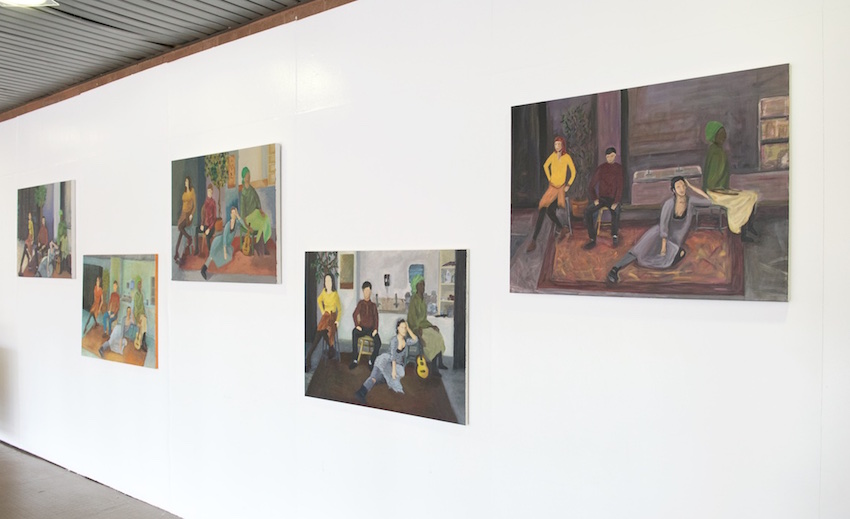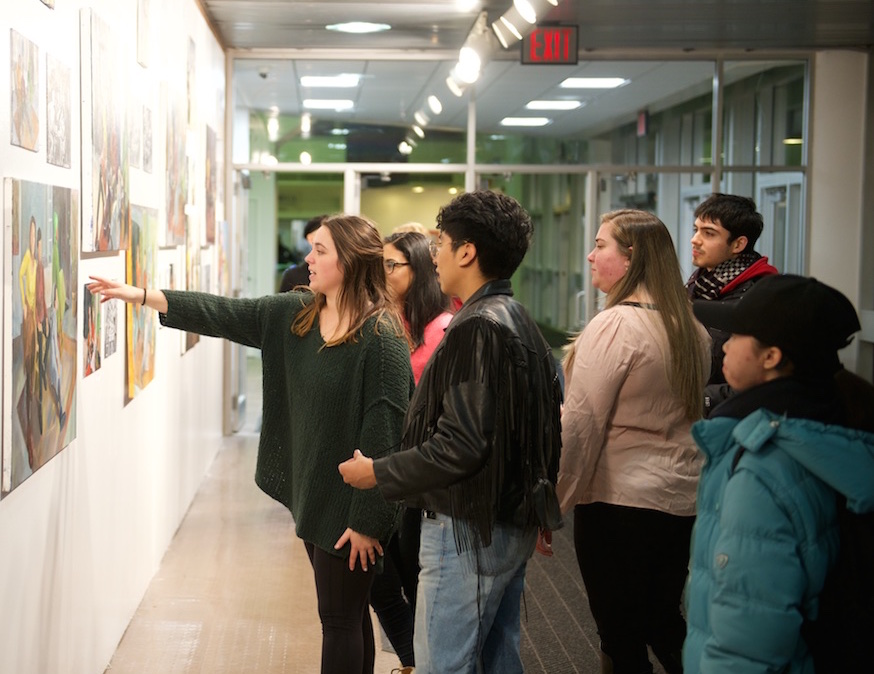
Negativity is frowned upon in college—but negative space has a valued role in the toolkits of advanced painting students at Borough of Manhattan Community College (BMCC/CUNY).
Liberal Arts major and aspiring painter Herron Hutchins puts it like this: “We learned that the background is just as important as the foreground.”
She’s standing in front of her final class project, a 30-by-40-inch oil painting that features a small group of models who sat for the class over a 5-week period.
Hutchins’ piece, and those of her classmates, are part of an exhibition showcasing Painting Studio III (ART 374) and Painting Studio IV (Independent Study, ART 903) final projects, on display now in the Theatre 1 Breezeway Gallery at 199 Chambers Street. An opening reception was held December 14 and the exhibition will run through February 7.
Step-by-step preparations for the large canvas
Thaddeus Radell, Director of the Art Program in BMCC’s Music and Art Department—and a painter whose work has been featured for more than 30 years in exhibits throughout the Eastern Seaboard, Paris and New York City—says the students started with a small charcoal drawing based on Cezanne’s The Card Players. Next, they completed a black-and-white composition study of the same painting, and finally, they made a small color study.
“Then and only then,” Radell says, “were they allowed to move to the big canvas.”
Their subject for that phase of the project was a group of four models who sat for the class for five weeks. Students noticed the light on the models, the drape of fabric on the clothes they were wearing, their posture and other qualities, as they rendered the scene into art on the blank canvas before them.

“They all drew the same configuration of models, who were seated in a circle at the front of the room,” Radell says. “It has actually been a great incentive to get them to class on time, so they can choose a seat with the best vantage point.”
Those shifts of perspective were among the qualities students focused on, as they took part in large-group critiques and gained fluency in concepts related to visual art.
“First you have to know the grammar, the principles behind a painting,” says Radell. “Art is a language of color and form, and the students in my classes learn how to talk about and compare paintings. I talk to them as I would to graduate students and they pick it up quickly. I ask, ‘Does each color plane have a weight and function?’ and they talk about the rhythm of the color, the plasticity of the painting itself and many other aspects.”
Making every inch of the painting serve its purpose
As he walks through the exhibit of his students’ work, Radell says there are successful “sections” in all of them.
“In this one,” he says, stopping to comment on one of the student pieces, “every color plane has been carefully mixed. Whenever a section or plane is interrupted, the color changes in a subtle way. Nothing is taken for granted. This student artist is thinking about the negative space. In fact, that is Cezanne’s famous mantra—‘The negative space is as important as the positive space’.”
Herron Hutchins, whose work is included in the show, takes that mantra to heart. “Paul Cezanne works a lot with light and dark tones. It’s a lot about the edges, where one color meets the other. That’s the important message, and that’s what I tried to do in my work.”
“We tried to make sure every inch of the painting serves its purpose,” she says, and points to her painting hung eye-level in the gallery. “If you don’t have underlying shapes and colors right, here on the face, the eyebrows won’t make sense.”
Not all art students at BMCC are aspiring visual artists, but many aspire to careers that place them in the field of fine art. According to Hutchins, the painting classes have given her insight into creativity, itself. “I need to be able to talk about the work and understand what I’m looking at,” she says.
Setting the stage for a vibrant community of artists
While BMCC already offered Painting Studio I (ART 174), new courses include Painting Studio II (ART 274) and Painting Studio III (ART 374), as well as the Independent Studies courses Painting Studio IV and Painting Studio V (ART 903), Radell says.
These courses are offered through the Music and Art Department, and can build toward an Associate of Arts (A.A.) in Art Foundations: Art History, or an Associate of Science (A.S.) in Art Foundations: Studio Art. Graduates of both programs are on track to transfer to bachelor’s degree programs at Queens College, CUNY.
“I’m really thankful to Dean [Erwin] Wong for being supportive of the advanced painting classes,” Radell says. “He let us put them in place, even though the enrollment was low at that time. Now we have a vibrant community of student artists, who are very serious about what they’re doing.”
Radell, who is also the faculty advisor for the BMCC Painting Club, is inspired by the emerging artists he meets in class and during club meetings.
“I admire their perseverance, their focus,” he says. “They have respect for the art of painting, and for each other’s work. I tell the students, ‘You are a painter. We stand when we paint. We hold our palettes’. You can hear a pin drop, when they are working at their canvases.”
Studio Painting III student artists on exhibit
Tenzin Choedon IV
Noelia Duarte
Greg Griffith
Herron Hutchins
Shuqi Li
Rachael Phillips
Mark Saldana
Vashtie Seebarran
Studio Painting IV student artists on exhibit
Xiaorui Huang
Massimo Scoditti
Krisztina Simon
STORY HIGHLIGHTS
- Painting students model their work on the paintings of Paul Cezanne and exhibit their final pieces
- Students can earn an A.A. in Art Foundations: Art History or A.S. in Art Foundations: Studio Art
- Whether aspiring artists or entering the business of art, student painters learn concepts that inform their understanding of art

